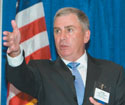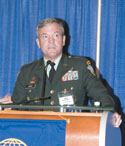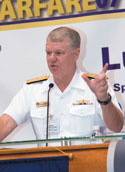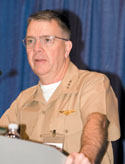 |
“It took us over two years to figure out how to share data with Australia and the U.K., and we still haven’t figured out how to share it with other members of the coalition.”
—Gen. John P. Abizaid, USA (Ret.), former commander, U.S. Central Command |
Terrorists’ adaptability compels allies to let go of the old and grab on to the new.
Leaders from across the length and breadth of the military agree that the Global War on Terrorism has uncovered serious shortcomings in today’s force. While warfighter performance continues to shine, nearly every element of the institutional military structure needs serious revamping to fight sophisticated, well-networked adversaries who employ high-technology and rudimentary capabilities so effectively that coalition forces must regroup and rethink their strategies. From antiquated acquisition processes to cyberspace activity and protection neglect, frontline commanders say the status quo has to go and deep changes must be made for the United States and its allies to win the war.
Force leaders have several recommendations about what must be done. Though they do not advocate terrorist techniques as extreme as torture, many suggest that the best line of attack is to leave traditional tactics behind and work on emulating the enemy. Adaptive ship designs, multipurpose unmanned aerial vehicles, persistent surveillance and reconnaissance, and multinational communication sharing must be pursued, but low-tech capabilities and dispersed decision-making are tactics that also can expand strategic options, they assert.
Military commanders and senior civilian U.S. Defense Department personnel candidly expressed their opinions about the state of the military at the Transformation Warfare conference, sponsored by AFCEA International and the U.S. Naval Institute in Virginia Beach, Virginia, in June. While ceaselessly commending warfighters, these decision-makers held little back as they critiqued Defense Department inner workings. Their frustration showed as they discussed incessant problems. In some cases, these problems have grown in severity; in others, the solutions have been so slow in coming that by the time they are instituted, they are no longer valid.
Although the picture they paint appears somewhat bleak, the fact that so many agree about the challenges the services face demonstrates that the military leadership has progressed from what in reality has been merely “lessons observed” to truly “lessons learned.” The overarching view is that the armed services have been using old thinking to fight a new kind of enemy, and as a result, many of the most critical issues remain.
 |
“Innovation has to be there to reconstitute and reinvent the force, especially in a financially constrained environment.”
—Lt. Gen. John R. Wood, USA, deputy commander, U.S. Joint Forces Command |
For example, Lt. Gen. John R. Wood,
USA, deputy commander, U.S. Joint Forces Command, referred to the problem of combating improvised explosive devices (IEDs) as a “conundrum that is confounding the military.” Adm. Gary Roughead, USN, commander, U.S. Fleet Forces Command, stated that in the area of information sharing the
U.S. military and government agencies have been suffering from inertia in gathering, classifying and distributing information. “Most information sharing is stymied not by technology but by policy,” he affirmed. In terms of acquisition processes, James Craft, deputy chief information officer, U.S. Marine Corps, submitted that the need for reform is so deep that it is more than the military can address on its own. “We are struggling to keep up and to acquire the needed technology within the observe-orient-decide-and-act loop,” he revealed.
Rob Carey, chief information officer, Department of the Navy, asserted that the military acknowledges that the need for speed and agility is great, but he admitted the services are falling behind in designing the doctrine that goes with the new capabilities. The lag time between the fielding of communications equipment and establishing the doctrine to use it is diminishing the effectiveness of capabilities, he said.
 |
“Most information sharing is stymied not by technology but by policy.”
—Adm. Gary Roughead, USN, commander, U.S. Fleet Forces Command |
Traditional
U.S. and multinational doctrines are not only outdated but
have become a maze that slows reaction time to a crawl. Conversely, terrorist networks that before were widespread yet tightly knit now adapt to
U.S. strategies even quicker than in the past—sometimes changing their tactics in hours or days—even when allied offensives restrict their communications, Carey said.
The issues military leaders identified were verified by the recent experiences of Gen. John P. Abizaid, USA (Ret.), former commander, U.S. Central Command. The commander openly related that he had experienced networking problems while conducting operations in Iraq. Networks that had been built to enable data-sharing among the services, agencies and other nations still are not performing as promised. “It took us over two years to figure out how to share data with Australia and the U.K., and we still haven’t figured out how to share it with other members of the coalition,” he disclosed.
Networking on a broader scale—specifically the Internet and cyberspace as a whole—also troubles Gen. Abizaid. From the standpoint of defense, he is adamant that the United States and its allies protect their interests, and he is certain that terrorists view cyberspace as one more battlefield, one more arena for attacks. He believes industry plays an active role in protecting the networks.
The enemy also is using the Internet as a weapon, the general explained. It is the vehicle for psychological operations as well as funding avenues. The U.S. military discovered that some al-Qaida funds were being delivered via PayPal. Shutting down this type of use of the Internet is not an easy task, Gen. Abizaid admitted. “How do we restrict Internet usage without putting restrictions on our freedom?” he questioned. But the general said he is not discouraged because “the U.S. and its allies have a lot of smart people who will find a solution.”
Gen. Abizaid identified additional deficiencies from his experience in Iraq, and said they must be resolved. “Every platform we build must be a joint sensor to aid all warfighters. Specialized platforms per service must be a thing of the past. Also, military platforms that don’t interoperate with other government and coalition platforms must be a thing of the past,” he stated.
 |
“The process cannot become more responsive unless we [consumers] are willing to take ownership of a piece of the process.”
—Rear Adm. Jan Hamby, USN, director of global operations, Naval Network Warfare Command |
Other military leaders agreed with Gen. Abizaid that business as usual is no longer acceptable. Faced with looming resource reductions, the military must dig deep into antiquated acquisition processes and revamp them from the ground up. Rear Adm. Jan Hamby, USN, director of global operations, Naval Network Warfare Command, proposed that real acquisition reform requires turning the existing process on its head. Instead of examining a mission and deciding what is needed to achieve it, the Defense Department must determine the effects it wants to generate, create a mission architecture and then acquire the capabilities it needs to achieve them. “The process cannot become more responsive unless we [consumers] are willing to take ownership of a piece of the process,” she stated.
Military leaders expressed concern about the disintegration of unity and a continued lack of collaboration between the military and other federal government agencies. Prior to the terrorist attacks on September 11, 2001, these conditions were tolerable; in the midst of the Global War on Terrorism, they are literally proving to be deadly. Gen. Wood recommended a coordinated focus on post-operations planning, a tactic the enemy employs well to win the minds and hearts of residents yet sorely lacking in U.S. and allied planning. It would include involvement from the government organizations most experienced and best suited to help reconstruct governments as well as schools and houses, and to restore economies to support the new state of a country. This is very likely not the military, he advised.
 |
“In the U.K., we have looked at what we’re doing today in Iraq to identify what’s working, and we know that in Iraq what we’re doing
is not working.”
—Cdre. Steve Cleary, RN, deputy director, U.S. Second Fleet, Combined Joint Operations from the Sea Center of Excellence |
Many of the military leaders pointed out that change is needed not only in the nuts and bolts of military operations but also on a broader scale. The
United States must repudiate one notion that has been creeping up in word and deed and involves both technology and tactics. Cdre. Steve Cleary, RN, is concerned that countries that want to join the fight against terrorism do not have a say about how it should be done and must adopt the plans, tactics and technologies of the large allied countries. The commodore, who is the deputy director,
U.S. Second Fleet, Combined Joint Operations from the Sea Center of Excellence, said that the current
U.S. and allied attitude is “either join me or get out of my way.” This stance concerns him because many countries have a lot to offer but are reluctant to just follow the leader, he stated.
The U.S. mind-set essentially forces countries that want to work with the allies to buy technology many cannot afford, he added. But he pointed out that solving the problems in information sharing does not necessitate spending more money but rather improving doctrine, especially as it relates to the classified level. “The technology is available, but getting permission to use the technology is where the process stutters and slows,” Cdre. Cleary said.
On the operational and strategic levels, military leaders emphasized that a sea change is needed in uniting efforts and shaping the operational environment. “In the U.K., we have looked at what we’re doing today in Iraq to identify what’s working, and we know that in Iraq what we’re doing is not working,” the commodore stated.
The consensus on the enemies’ profile remains the same as it was even before the terrorist attacks: agile, adaptive and ruthless. However, some nuances are emerging. While Defense Department leaders have always recognized that the threat is asymmetric, attacks during the past several years indicate an enemy that is in some cases even better networked than the U.S. military, according to Gen. Abizaid. And networking is not the only area in which adversaries may be more successful than allies. Capt. Timothy G. Szymanski, USN, maintains that the U.S. must be adaptive and agile “at the speed of war,” but this is not the case. “That might be one area where were behind our enemy,” noted the Joint Staff’s deputy chief of global special operations, Directorate for Special Operations.
Innovation is at the top of nearly every military leader’s priority list. It must be encouraged and promoted or the military will revert to traditional methods of warfare that do not work against today’s enemies, Gen. Wood said. “Innovation has to be there to reconstitute and reinvent the force, especially in a financially constrained environment,” he stated. When asked if innovators are being fully tapped to meet today’s Defense Department needs, the general replied that the military has done well in encouraging and rewarding innovation in large corporations, but it needs to improve its interactions with small companies and academia.
One nontechnical area that must be addressed is the lack of knowledge about the enemies’ cultures and how culture influences their tactics. Gen. Abizaid pointed out that the war in the Middle East is one about ideology, not riches or land. “We are not in a war against terrorists; it is a war against people who have an idea,” he emphasized. Because Western culture is one that encourages open discourse and acceptance, Americans and Europeans cannot understand this, but it is an extremely important point to remember when developing tactics. Gen. Abizaid believes it is the media’s responsibility to educate the public about the differences in cultures so people can understand why fighting is necessary and why it is so important to prevail.
 |
“War has not changed, and we need to be ready for a cross-section of conflict that includes chaos, friction and uncertainty.”
—Lt. Gen. Keith J. Stalder, USMC, commanding general,
II Marine Expeditionary Force |
Not all of the military leaders at the conference agreed that war today differs greatly from past conflict. Lt. Gen. Keith J. Stalder, USMC, commanding general, II Marine Expeditionary Force, is concerned that the
U.S. military is allowing the current war to dominate its thinking and is incorrectly concluding that the character of combat is changing. “I don’t believe that at all,” he stated.
“The fundamental nature of fighting is the need to be able to do it all. The priority today is war and low-intensity conflict. Most of the risk and vulnerability to our nation is in high-end conflict. Everyone—including the enemy—gets a voice in what type of conflict it will be, so we don’t have a choice. War has not changed, and we need to be ready for a cross-section of conflict that includes chaos, friction and uncertainty,” Gen. Stalder maintains. The best way to deal with this is by pushing decision-making to the lowest echelons, he added.
Many of the military and government leaders who spoke at the conference pointed out that the cost of the war is escalating and that cost is more than just funding. The United States’ reputation is on the line. The willingness of other nations to align themselves with the United States in the future is at stake. If the military continues to spend money without tangible, observable results, the trust of the American people may hang in the balance.
All of the speakers reiterated the need for industry to do all it can to support the war effort by following standards, building reliable systems, designing enterprise rather than single solutions and persisting in their willingness to work with the military even though the acquisition processes can be extremely frustrating.
Web Resource
Transformation Warfare 2007: www.afcea.org/events/transformation










Comments